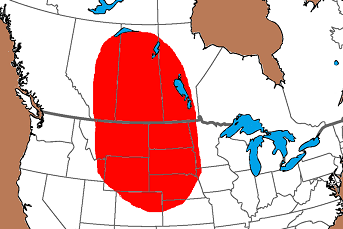Name Details:
Named By: Richard "Scotty" MacNeish
Named For:
Date Identified: 1954
Type Site: Stott
Mound and Village near Brandon, Manitoba, Canada
Prairie Side Notch
Cluster: Plains Small Side Notch Cluster
Commonly Utilized Material:
A variety of locally available materials commonly heat
treated.
Date:
Cultural Period:
Glacial Period:
1,400 - 700 B.P.
Developmental
Vandal Minimum to
Medieval Warm
Scandic to Pacific periods
Outline is Representative of Common Size and Shape:
Description of Physical Characteristics and Flaking Pattern:
This is a small point with an elliptical to flattened cross section. The blade may range from straight to excurvate generally lack crisp,
straight sides. Kehoe (1967) describes
this point as "irregular outline and poorly defined angles". This point has broad and shallow parallel notches creating shoulders that are slightly angled upward.
Parallel notches are generally wider than they are deep and form a stem
that is expanding with rounded corners. The base is most commonly straight, but may be slightly concaved or convex.
The base is slightly narrower than the shoulder width. This point has a random flaking pattern with poor quality flaking.
Size Measurements: Length - 11
to 41 mm (22.1 mm mean), Width - 9 to 22 mm (14.1 mm mean), Thickness - 2 to
8 mm (3 mm mean)
Distribution:
Distribution Comments:
This point is associated with nomadic bison hunters of the plains and prairie region. This point is found from the plains of Saskatchewan and Alberta into the Plains of
Montana, North and South Dakota. May be found into the plains region of Colorado, Nebraska and into Kansas.

Similar Points:
Besant, Billings, Bitterroot, Buffalo Gap, Cayley, Cluny, Cut Bank, Desert, Emigrant, Harrell, Irvine, Mortlach, Nanton, Pekisko, Paskapoo, Prairie, Rustad Quarry, Washita Additional Comments:
Avonlea points are the earliest of the Plains Small Side Notch cluster.
This cluster is thought to evolved from the Pelican Lake points.
This was the predominate type used from 1,300 until 700 B.P. This point was replaced by the Plains Side Notch (Kehoe, 1966).
Prairie Side-Notched is distinguished from Plains Side Notched points
largely by its less symmetrical shape and poorer workmanship (Kehoe 1966)
Prairie Side-Notched points are essentially identical to Reed points and Des
Moines points (Morrow 1984).
Pictures Provided By:
Jerry Dunlop
Evan Hill
Rothbob
References: (See Reference Page, Entry Number):
23, 30, 36, 79, 168, 176, W2
Other points in this Cluster:
Point Validity: Valid Type
MacNeish was a pioneering anthropologist who was most notable for his excavations and studies at Tamaulipas Mexico. This type has been references in professional
publications and is considered a valid type.
Age Details:
This point is associated with the One Gun Phase of Alberta, Saskatchewan, and into Montana. and the Old Woman Complex of Canada.
Prairie Side Notch Projectile Point, Prairie Side Notch Arrowhead





.jpg)

